How to Choose a Surfboard: Size Chart and Liter Calculator
The process of choosing a surfboard that is right for you can be daunting whether you are a novice or seasoned surfer. There are a number of different shapes, sizes, materials, and external factors that can make choosing a surfboard a bit overwhelming.
Luckily, you are not alone on your mission to shred the gnar and get a new surfboard that puts you on the best wave of your life. Stay tuned to learn more about all the different aspects of buying a new surfboard.

Daniel Lofaso
SwellSpy Founder
Parts/Anatomy of a Surfboard
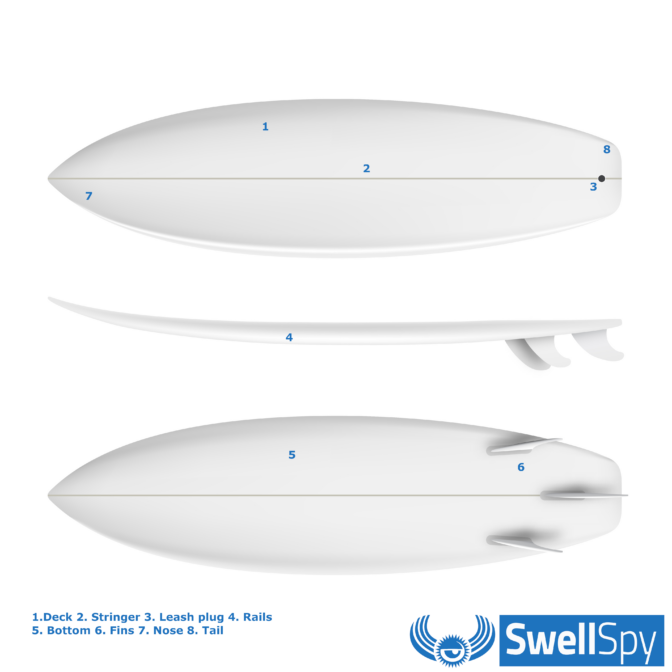
- Deck: The top of the surfboard and where you stand.
- Stringer: A narrow piece of wood that sits in the middle of the surfboard that runs from the tail to the nose. A stringer helps to create stiffness and reduce flexibility. Not all surfboards have stringers.
- Leash plug: The lease plug is placed on the deck of the board towards the tail. It is used to attach a leash rope that secures the leash in place.
- Rails: The rails of a surfboard are its edges. They run from the nose to the tail on both sides of the board and their shape dictates how water moves around the board.
- Bottom: The bottom of the surfboard is the area that is touching the water and has the biggest effect on how much drag it will have. There are different bottom contours for different types of boards and often combinations of contours. This is also the area the fins are placed.
- Fins: Fins are responsible for the stability and control you have while riding waves. They are located towards the tail of the board, on the bottom. Surfboards can have three, four, one, and sometimes five fins.
- Nose: The surfboard nose influences how it paddles, floats, catches waves, and more. Bigger wider noses are associated with buoyancy while narrower noses are associated with more maneuverability.
- Tail: The tail is the back of the surfboard and the last place water flows when riding a board. Like a nose, the tail can influence speed, control, and floatation.
The surfboard is made up of eight primary parts:
Surfboard Shape
Volume is a surfboard metric that provides a measurement of the floatation of the board. For intermediate and advanced shortboard surfers it is likely the primary way they decide on boards to purchase once they have decided on a shape.
On surfboards, volume is defined by cubic liters (CL), but is usually referred to by just liters, or an “L” after the dimensions. For example, I am an intermediate to advanced surfer and I prefer a volume range in the 29L area (I’m 6’1” and 165 pounds (at the time of this writing)).
Volume is a calculation of length × width × height although most surfboard shapers will write the volume right on the board for easy reference. If you know the board shape you want, check out our nifty surfboard volume calculator below to get an idea of some volume ranges that might work for you.
Dialing in your volume range (again, labeled as liters or an “L” on most surfboards) will make your surfboard purchasing decisions much easier once you decide on the shape you want.
Note that midlengths and longboards are high volume surfboards and that the above takeaways don’t really apply. Pretty much all longboards can float anyone, so for these types of shapes you are going to want to reference the dimension metrics based on what you feel comfortable with until you are really dialed into what volume you want on a longboard.
Dialing in your volume
Here are some takeaways in regards to shortboard surfboard volume and choosing a surfboard:
- Heavier surfers tend to want more volume than lighter surfers
- Beginner surfers tend to want more volume than advanced surfers
- Most surfers like to stay within a volume range to predefine surfboards that will likely perform well for them (with different ranges for funshapes and longboards)
Take me to the Surfboard Volume Calculator
Surfboard Dimensions
Back in the days before surfboard shapers used to utilize volume measurements, all surfers had to go by were dimensions. Thank goodness those days are behind us.
Dimensions are an important consideration, however shape and volume are arguably much more important as they dictate surfboard performance capabilities as well as your proper buoyancy range.
Dimensions are measured in length, width, and thickness.
Length
The height or length of your surfboard will be partly based on the shape you get as well as your height. For shortboards, most surfers get boards that are a few inches shorter than their height for their day-to-day boards. As stated before, volume will probably be a better reference point here for shortboards and fish shapes.
Width
As a rule of thumb, the wider a surfboard is the more user-friendly it will be. A narrower surfboard will be more “bladey” and is generally suited for more high-performance surfing.
For example, a shortboard made for high-performance surfing will likely be in the 18” to <20” width range while a funshape or longboard will easily be over 20” wide but likely under 24”.
Thickness
Thickness is the third dimension of a surfboard to become familiar with and probably the least understood. A surfboard with a short height could still perform well and provide lots of buoyancy if it has ample thickness.
For most shortboards the thickest part of the board is the area right underneath the chest (when paddling). You’ll likely see surfboards in the thickness range of >2” to a little over 3” for bigger boards. Thickness increases tend to be very subtle on surfboards as they go from lower volume to higher volume. For example, it is not uncommon to see a 5’7” surfboard with a thickness of 2 3/16” and a 6’1” with a thickness of 2 9/16”.
Here is an example of how surfboard dimensions will be written on a board as length x width x thickness and then volume.
5'7" X 18 5/8" X 2 3/16" - 24.02L
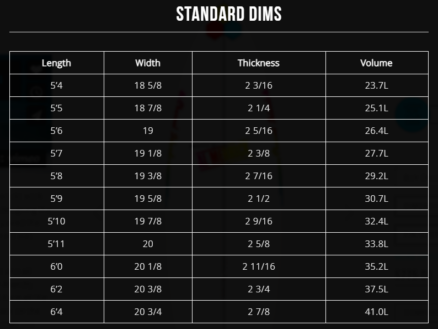
What Size Surfboard Should I Get?
The size of the surfboard you should get should be consistent with your skill level, the waves you will be surfing in, your weight, and your desired shape. There is no one size fits all surfboard, it is very much a personal preference although I can give some general recommendations.
Here are some surfboard recommendations based on some assumptions about the waves you will be surfing:
For newbie surfers
First-time surfers who are starting their surf journey will likely want something that is very buoyant, forgiving, and provides a bit more safety than the common surfboard. Since you will be riding very small waves, you are likely going to want to get a soft top surfboard. Soft top surfboards are usually longboards or funshapes and have the ideal volume and paddle power that a beginner needs. Because the top of the board is soft (and the fins are usually not sharp), they make for an ideal entry-level surfboard that can be used until you want to progress.
For novice surfers
T he novice surfer who can stand up and has elevated their surfing to slightly bigger waves will be happy to ride a funshape or beefy fish. These boards still have some decent buoyancy and paddle power which allows you to get into waves early and provides the forgiveness needed to have fun as your surfing is still progressing.
For intermediate surfers
Intermediate surfers can open up their repertoire of surfboard shapes to whatever it is that they prefer. If you choose the shortboard route, you’ll probably just want to go up slightly in volume than someone who is more advanced. Intermediate surfers will be happy on a funshape, fish, or shortboard depending on the waves they like to surf and how much buoyancy they are looking for under their feet.
For advanced surfers
Advanced surfers love speed, maneuverability, and the ability to do progressive maneuvers. For this reason they are generally happiest on a standard shortboard where they can get down the line fast, do turns in the pocket, and get barreled.
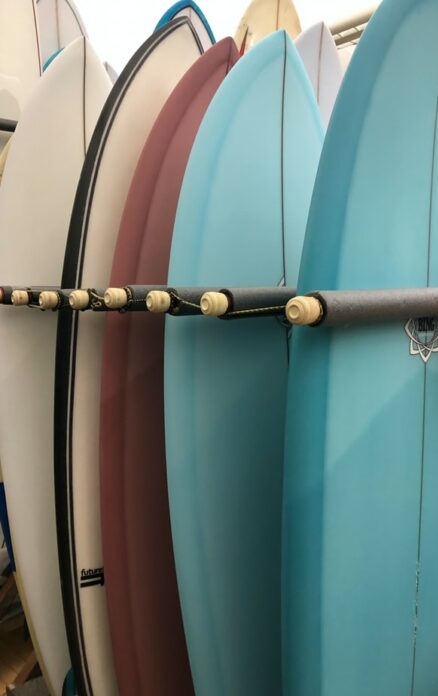
Surfboard Volume Calculator
Learn more about how to calculate surfboard volume and other factors that may influence volume here.
What Type of Surfboard Should I Get?
The type of surfboard you get should factor in the waves you are surfing as well as your ability level. It should also take into account the type of surfing you want to do (or try to do).
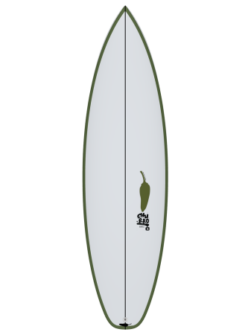
Shortboard
Qualities: narrow, sharp nose, minimal thickness
Ideal conditions: 2’ to 20’
Best for: intermediate to advanced surfers
Shortboards are the most common types of surfboards but are not suitable for all surfers or all types of waves. If you want to surf more vertical waves and perform higher performance maneuvers like in the pocket turns, airs, or barrels, a shortboard may be for you. These boards can work in waves from 2’ and up, although they may be a little challenging for beginners or those trying to surf weaker, smaller waves.

Fish
Qualities: stubby nose, “fish” tail, flatter design
Ideal conditions: 1’ to 6’
Best for: beginner to advanced surfers
Fish surfboard shapes are very versatile and can generally be surfed by beginners and advanced surfers alike. They are a bit more forgiving due to their shape and thickness, and tend to work best in smaller waves without sacrificing too much in the performance department. Whereas shortboards are best for in the pocket surfing and progressive surfing, fish surfboards are better suited for more cruisy, horizontal surfing while still maintaining a fair amount of speed. Some fish shapes may still be too small for the most entry-level surfers, but are great all-around boards for the average surfer.

Midlength / Funshape
Qualities: wide, round nose, 7’ to 8’+/-
Ideal conditions: 1’ to 4’
Best for: beginners
Funshapes are smaller than a typical longboard but about a foot or so longer than your typical shortboard. They also have a wide nose and provide lots of stability, making them fun on small waves as well as a great option for beginners. They are a slight graduation from longboards as they are more maneuverable and can turn more easily.
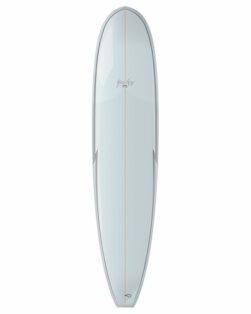
Longboard
Qualities: wide, round nose, 8’+
Ideal conditions: 1’ to 4’
Best for: beginner to advanced surfers
Longboards are great learning surfboards because of the amount of volume they provide. They work in the smallest of waves and are the most forgiving of all shapes. What they benefit from in terms of ease of use, they lack in maneuverability. Longboards are to be used for horizontal surfing and cruising (except for very advanced longboarders of course).
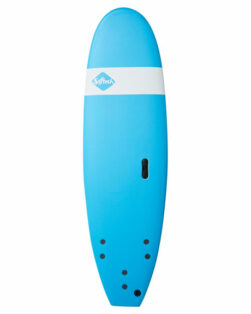
Soft Top
Qualities: foam top, resemble a funshape or longboard
Ideal conditions: 1’ to 4’
Best for: beginners
Soft top surfboards are best for beginners although they have been making their way into lineups where more advanced surfing takes place. Because they are both buoyant and soft, they are great for getting into waves without presenting the risks of a harder construction. Soft tops come in all shapes and sizes, but generally are longboards and funshapes.
What Type of Surfboard Fins Should I Get?
In case you were wondering, fins do not come with surfboards, you have to choose and buy them accordingly.
Except for the out of the box soft top that comes with fins attached, here’s what you’ll have to consider when choosing which fins to get for your surfboard:
Check out our complete guide to surfing fins
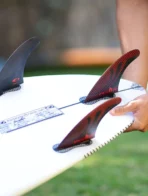
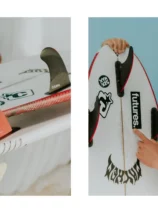
Fin Box
Your fin box is the most simple fin decision you’ll have to look at because it is predetermined by the surfboard you buy. The most popular two options are FCS and Futures, so you’ll want to buy FCS fins if you have an FCS fin box and Futures if you have a Futures fin box.
If you are ordering a custom surfboard you’ll usually have the option of deciding what types of fin boxes you want on your board. This comes down to personal preference. I’d say try and stick to one fin box so that you can interchange your fins across different boards without having to purchase fins from lots of different brands.
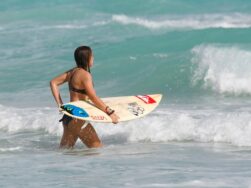
Your Weight
FCS and Futures both use weight parameters as guides for fin size. Keep in mind these are not hard and fast rules, you can go up or down from your range slightly in the event you want a different feel.
FCS fins weight & size recommendations:
- X-Small (Under 55Kg / 120 Lbs)
- Small (55Kg - 70Kg / 120 - 155 Lbs)
- Medium (65Kg - 80Kg / 145 - 175 Lbs)
- Large (75Kg - 90Kg / 165 - 200 Lbs)
- X-Large (Over 85Kg / 190 Lbs)
Futures fins weight & size recommendations:
- X-Small (75-115lbs)(34-53kg)
- Small (105-155lbs)(48-70kg)
- Medium (145-195lbs)(65-88kg)
- Large (180lbs+)(80kg+)
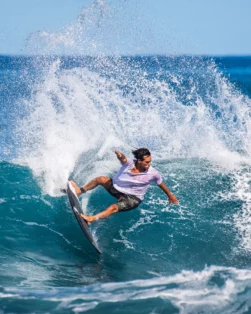
Waves
The waves determine whether you are looking for fins that create speed (smaller waves) or create control (bigger waves). Luckily, the fin brands provide some great resources on how to select fins based on what your goals are.
FCS has fin families for:
- Finding speed
- Finding balance
- Finding control
- Finding power
Futures has fin families, called Ride Numbers, for:
- Generating speed
- All around balance
- Controlling speed
Thruster or Quad (or Twin Fin)?
Thruster or quad fin setups apply to the fin boxes in the board. Thrusters refer to a three-fin setup, one in the back, and two fins right under the tail pad. A quad setup refers to a four-fin setup where the two sets of fins are staggered on the right and left side of the board with no trailing fin.
Thrusters are the most common fin setup as they are the most versatile and best suited to all types of conditions. Quads are known for their ability to generate speed but offer slightly less control than the thruster because of the lack of a trailing fin.
Then of course there is the twin fin, which as the name suggests, consists of two fins. Most twin fin surfboards utilize twin fin setups, meaning throwing two fins from your thruster fin set will most likely result in a lack of performance in the way the shaper intended.
Some surfboards offer hybrid fin setups where you can use the board as a thruster or a quad.
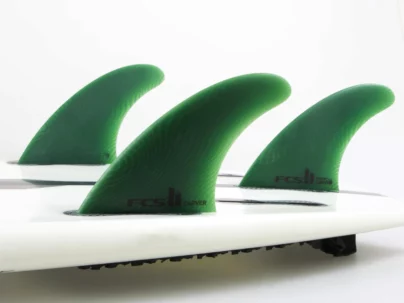
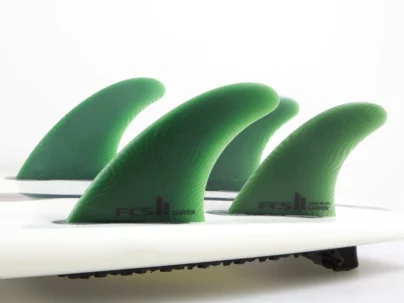
What Type of Leash Should I Get?
An additional consideration for your surfboard purchase is the leash. The leash is what attaches to your ankle and is what keeps the board from getting caught by a wave and ending up on the beach.
In a sense, it is a safety device not only for other people in the water but also for surfers who want to be able to access their boards quickly after falling.
The primary considerations for a surfboard leash are:
- Leash length
- Lease size
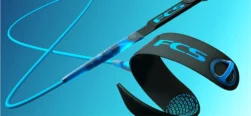
Leash Length
Your leash should be as long as your surfboard if not a couple inches longer. Most leash manufacturers create leash sizes by the foot: 6’, 7’, 8’, etc., although there are options within the 6 to 7 foot range. When in doubt, go slightly larger than what the length of your board is.
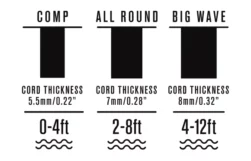
Leash Size
Lease size refers to the thickness of your leash. The thicker your leash, the better it will hold up in bigger waves. Leash thickness is measured in millimeters:
- Competition leash: 5.5mm
Ideal for smaller conditions under 4’
- All around leash: 7mm
Ideal for everyday conditions 2-8’
- Big wave leash: 10mm+
Ideal for heavier water waves 4-12’+
Best Surfboards for Women
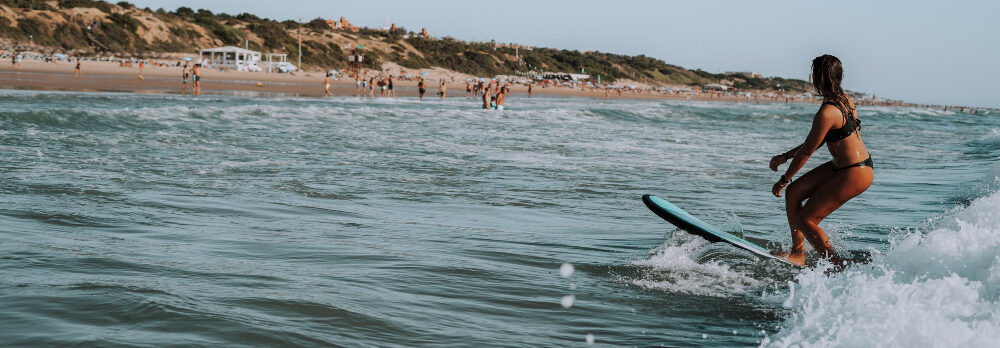
Because women typically have smaller frames than men, along with shorter arms and narrower shoulders, they may look for different surfboards than men.
However, it is extremely uncommon to find surfboards that are specifically designed for women despite the availability of some outwardly feminine color schemes. In other words, women and men can ride the same surfboards and unlike some other sporting goods, there are no explicit surfboards for women.
That said, the best surfboards for women will likely be narrower in width to account for the narrower shoulders. This likely only applies to inherently wider boards like funshapes and longboards as most shortboards will be narrow enough to accommodate most women’s surfing.
Bottom line: Most surfboards are unisex.
Best Surfboards for Kids
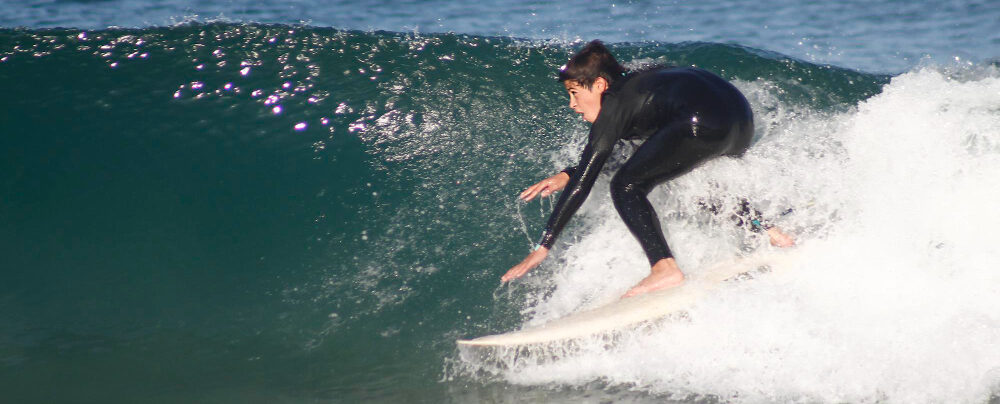
Kids’ surfboards are notably different from those for adults as they have obvious differences in arm length and shoulder width. As such, they need surfboards to accommodate their small frames. This applies to both boys and girls.
Note that in the surfing industry, kids are called “groms,” short for “grommet.” So when shopping for a grom board, you’ll want to look out for the following:
- A board that is a few inches taller than your grom
- A board with a width that is smaller than their shoulders; a good rule of thumb is that the grom should be able to put their arms around the deck of the board
- A soft top for a very young grom or a grom completely new to surfing to avoid getting injured by other tougher, sharper materials
Today there are a number of surfboard brands and shapers that make boards specifically for groms. Look for these options when selecting a grom board or take into consideration the above specifics about dimensions.
Surfboard Costs
The last few years have resulted in a notable increase in the price of surfboards. Materials costs have gone up for shapers and these costs have been passed down to the consumer. Here are some relative costs you can expect for new surfboards in shops or online:

Shortboard costs
Price Range: $600 to $900
Shortboard costs can range anywhere from $600 to $900, depending on the credibility of the brand, the material, and the demand of the surfboard.
Top brands, referred to as shapers, are known for their ability to produce consistently good surfboards and often do so for top level pros. These brands tend to fetch higher dollar amounts than lesser known brands.

Fish costs
Price Range: $600 to $900
Fish surfboard costs rival that of shortboards and are easily in the $600 to $900 range for new boards.

Midlength / Funshape costs
Price Range: $700 to $1,000
Funshape surfboards are a bit bigger than shortboards and smaller than longboards so their prices reflect this difference. Most funshapes start at the upper end of the shortboard spectrum – around $700 – and can go as high as $1,000.

Longboard costs
Price Range: $800 to $2,000+
Longboard surfboards are amongst the most expensive of all surfboards because they have the most materials. Expect to pay $800 to $2,000, or more, for these boards.

Soft Top
Price Range: $300 to $400
Soft top surfboards are the most entry-level in terms of cost. You can get a new soft top board for around $300 although they can easily go upwards of $400. Keep in mind that soft top boards are more of a material description than a shape description. For this reason, soft top boards can be shortboards, fish, funshapes, or longboards. As such, the different soft top shapes can cost anywhere from $300 to $550 for soft top longboards. Soft tops, however, do come with fins so that is one less expense you have to consider.
